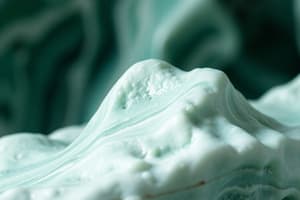Podcast
Questions and Answers
Which strength measures a material's ability to withstand bending loads?
Which strength measures a material's ability to withstand bending loads?
- Fracture Toughness
- Compressive Strength
- Elastic Modulus
- Flexural Strength (correct)
Fracture Toughness is a measure of a material's ability to resist crack propagation.
Fracture Toughness is a measure of a material's ability to resist crack propagation.
True (A)
What is the term used to describe the maximum stress a material can withstand while being compressed?
What is the term used to describe the maximum stress a material can withstand while being compressed?
Compressive Strength
The ratio of stress to strain in the elastic deformation region is known as ______.
The ratio of stress to strain in the elastic deformation region is known as ______.
Match the following terms with their definitions:
Match the following terms with their definitions:
Which property makes zirconia a desirable material for orthopaedic implants?
Which property makes zirconia a desirable material for orthopaedic implants?
Alumina is known for its high wear properties and biocompatibility.
Alumina is known for its high wear properties and biocompatibility.
What type of carbon is widely utilized for implant fabrication?
What type of carbon is widely utilized for implant fabrication?
Zirconia has a melting temperature that is significantly higher than that of __________.
Zirconia has a melting temperature that is significantly higher than that of __________.
Match the following materials with their key characteristics:
Match the following materials with their key characteristics:
Which material has bending strength and fracture toughness that is 2-3 times greater than alumina?
Which material has bending strength and fracture toughness that is 2-3 times greater than alumina?
Elastic modulus is also referred to as bending strength.
Elastic modulus is also referred to as bending strength.
Fracture toughness measures the energy required to __________ a crack.
Fracture toughness measures the energy required to __________ a crack.
What is the primary characteristic of non-inert bioceramics?
What is the primary characteristic of non-inert bioceramics?
Bioactive glass is an example of a natural resorbable bioceramic.
Bioactive glass is an example of a natural resorbable bioceramic.
What is one synthetic example of a resorbable bioceramic?
What is one synthetic example of a resorbable bioceramic?
Hydroxyapatite has a similar mineral composition to that of ________.
Hydroxyapatite has a similar mineral composition to that of ________.
Which of the following is a natural bioceramic?
Which of the following is a natural bioceramic?
What is the chemical formula of Hydroxyapatite?
What is the chemical formula of Hydroxyapatite?
Match the following materials with their type:
Match the following materials with their type:
The __________ in resorbable bioceramics must be processed through normal metabolic pathways.
The __________ in resorbable bioceramics must be processed through normal metabolic pathways.
What is the elastic modulus of enamel?
What is the elastic modulus of enamel?
Dentin has a higher elastic modulus than compact bone.
Dentin has a higher elastic modulus than compact bone.
What are the primary components of hard tissues such as bone and dental enamel?
What are the primary components of hard tissues such as bone and dental enamel?
Biocoral is transformed into hydroxyapatite by a chemical exchange reaction with __________ under hydrothermal conditions.
Biocoral is transformed into hydroxyapatite by a chemical exchange reaction with __________ under hydrothermal conditions.
Match the following materials with their elastic modulus values:
Match the following materials with their elastic modulus values:
Which factor influences the degradation rate of ceramics by increasing surface area interaction with the environment?
Which factor influences the degradation rate of ceramics by increasing surface area interaction with the environment?
Single crystal ceramics degrade more quickly than polycrystalline ceramics due to having more grain boundaries.
Single crystal ceramics degrade more quickly than polycrystalline ceramics due to having more grain boundaries.
What effect does a high amount of water have on the degradation rate of ceramics?
What effect does a high amount of water have on the degradation rate of ceramics?
Ceramic degradation is encouraged in areas with high mechanical __________.
Ceramic degradation is encouraged in areas with high mechanical __________.
Match the following factors with their effect on degradation rate:
Match the following factors with their effect on degradation rate:
What is the purpose of controlled crystallization?
What is the purpose of controlled crystallization?
A composition of 60% SiO2 in bioactive glass is considered very bioactive.
A composition of 60% SiO2 in bioactive glass is considered very bioactive.
What film layer must be formed simultaneously for bioglass to bond with bone?
What film layer must be formed simultaneously for bioglass to bond with bone?
Bioglass has a composition of 45 wt% SiO₂, 24.5 wt% CaO, 24.5 wt% Na₂O, and ______________.
Bioglass has a composition of 45 wt% SiO₂, 24.5 wt% CaO, 24.5 wt% Na₂O, and ______________.
Match the following ceramics with their primary applications:
Match the following ceramics with their primary applications:
What effect can small changes in the composition of a biomaterial have?
What effect can small changes in the composition of a biomaterial have?
Bioactive ceramics have minimal biological interaction.
Bioactive ceramics have minimal biological interaction.
Identify one type of glass ceramic besides Bioglass.
Identify one type of glass ceramic besides Bioglass.
Bioglass can bond with bone in approximately __________ days.
Bioglass can bond with bone in approximately __________ days.
Which property is NOT characteristic of bioactive ceramics?
Which property is NOT characteristic of bioactive ceramics?
Inert ceramics have high biocompatibility but minimal biological interaction.
Inert ceramics have high biocompatibility but minimal biological interaction.
What is the tensile strength range of alumina?
What is the tensile strength range of alumina?
Bioactive glasses with less than __________% SiO₂ are considered very bioactive.
Bioactive glasses with less than __________% SiO₂ are considered very bioactive.
Match the following properties with their values for bioceramics:
Match the following properties with their values for bioceramics:
Flashcards
Flexural Strength
Flexural Strength
A material's ability to resist bending.
Fracture Toughness
Fracture Toughness
A material's resistance to crack propagation.
Elastic Modulus
Elastic Modulus
Ratio of stress to strain in elastic deformation.
Alumina
Alumina
Signup and view all the flashcards
Zirconia
Zirconia
Signup and view all the flashcards
Pyrolitic Carbon
Pyrolitic Carbon
Signup and view all the flashcards
High Melting Temperature
High Melting Temperature
Signup and view all the flashcards
Biocompatibility
Biocompatibility
Signup and view all the flashcards
What are non-inert bioceramics?
What are non-inert bioceramics?
Signup and view all the flashcards
What are some examples of synthetic resorbable bioceramics?
What are some examples of synthetic resorbable bioceramics?
Signup and view all the flashcards
What are some examples of natural resorbable bioceramics?
What are some examples of natural resorbable bioceramics?
Signup and view all the flashcards
What is the most important calcium compound in the body?
What is the most important calcium compound in the body?
Signup and view all the flashcards
What does Hydroxyapatite do in the body?
What does Hydroxyapatite do in the body?
Signup and view all the flashcards
What is the chemical formula of Hydroxyapatite?
What is the chemical formula of Hydroxyapatite?
Signup and view all the flashcards
What is the Hydrothermal Technique?
What is the Hydrothermal Technique?
Signup and view all the flashcards
What is the Ca/P ratio in Hydroxyapatite?
What is the Ca/P ratio in Hydroxyapatite?
Signup and view all the flashcards
Hydroxyapatite's Elastic Modulus
Hydroxyapatite's Elastic Modulus
Signup and view all the flashcards
Hydroxyapatite in Hard Tissues
Hydroxyapatite in Hard Tissues
Signup and view all the flashcards
Enamel's Stiffness
Enamel's Stiffness
Signup and view all the flashcards
Dentin's Mineral Content
Dentin's Mineral Content
Signup and view all the flashcards
Bone's Mineral Content
Bone's Mineral Content
Signup and view all the flashcards
Compressive Strength
Compressive Strength
Signup and view all the flashcards
What are the important properties for load-bearing materials?
What are the important properties for load-bearing materials?
Signup and view all the flashcards
Controlled Crystallization
Controlled Crystallization
Signup and view all the flashcards
Bioactive Bioceramics
Bioactive Bioceramics
Signup and view all the flashcards
What defines bioactive bioceramics?
What defines bioactive bioceramics?
Signup and view all the flashcards
Bioglass® Composition
Bioglass® Composition
Signup and view all the flashcards
Why is Bioglass® bioactive?
Why is Bioglass® bioactive?
Signup and view all the flashcards
Bioactive Glass and SiO2 Content
Bioactive Glass and SiO2 Content
Signup and view all the flashcards
Inert Ceramics
Inert Ceramics
Signup and view all the flashcards
Non-Inert Ceramics
Non-Inert Ceramics
Signup and view all the flashcards
Biocompatibility of Bioceramics
Biocompatibility of Bioceramics
Signup and view all the flashcards
Degradation of Bioceramics
Degradation of Bioceramics
Signup and view all the flashcards
Tensile Strength in Bioceramics
Tensile Strength in Bioceramics
Signup and view all the flashcards
Compressive Strength in Bioceramics
Compressive Strength in Bioceramics
Signup and view all the flashcards
Flexural Strength in Bioceramics
Flexural Strength in Bioceramics
Signup and view all the flashcards
Fracture Toughness in Bioceramics
Fracture Toughness in Bioceramics
Signup and view all the flashcards
Elastic Modulus of Bioceramics
Elastic Modulus of Bioceramics
Signup and view all the flashcards
Grain Boundaries and Degradation
Grain Boundaries and Degradation
Signup and view all the flashcards
Water's Effect on Degradation
Water's Effect on Degradation
Signup and view all the flashcards
Surface Area and Degradation
Surface Area and Degradation
Signup and view all the flashcards
Mechanical Stress and Degradation
Mechanical Stress and Degradation
Signup and view all the flashcards
How does implant site location affect degradation?
How does implant site location affect degradation?
Signup and view all the flashcards
Study Notes
Ceramic Materials
- Ceramics are inorganic, non-metallic solids, typically oxides, nitrides, or carbides.
- They are hardened by high-temperature shaping.
- Ceramics are hard, brittle, and resistant to high compression stress.
- They are good insulators (electrically and thermally).
- Many ceramics appear aesthetically pleasing and are transparent to light.
Outline of Ceramic Materials
- Introduction
- Desired properties of bioceramics
- Types of bioceramics
- Degradation of ceramic
Desired Properties of Bioceramics
- Biocompatibility: Must be compatible with biological systems.
- Appropriate mechanical properties: Suitable for specific application.
- Degradation/Stability: Degradable or stable for the implanted time.
- Bioactivity: Actively interacts with the host tissues for their lifetime.
- Non-toxic: Should not cause harm to the body system.
- Non-carcinogenic: Should not cause cancer.
- Non-allergic: Must not cause allergic reactions.
- Non-inflammatory: Should not lead to inflammation.
Types of Bioceramics
- Inert (Non-Absorbable) Bioceramics: Maintain their properties in the host. Examples include Alumina, Zirconia, and Carbon
- Alumina: High hardness, low wear, inert. Used in orthopedic implants, femoral heads, and coatings. The main source is bauxite and corundum. It has high compressive strength, is chemically inert, and has good wear resistance.
- Zirconia: Obtained from zircon. Has high bending strength and toughness compared to alumina, excellent biocompatibility, and also used in orthopedic implants.
- Carbon: Generally used as a surface coating.
- Non-Inert (Resorbable) Bioceramics: Degrade in the body or absorbed by the tissues over time. Synthesised or natural. Examples include calcium phosphate and Biocoral.
- Calcium Phosphate: Used to create artificial bone. Examples include hydroxyapatite (HA) and tricalcium phosphate.
- Biocoral: A natural material transformed into HA. Ideal for repairing traumatized bone and correcting bone defects.
- Surface Reactive/ Bioactive Bioceramics: Interact directly chemically with the body's tissues or surrounding bone. Examples: Glass ceramics, hydroxyapatite.
- Glass Ceramics: Crystalline materials from controlled crystallization of an amorphous glass. Specific compositions and controlled nucleation are needed to achieve controlled crystallization and small, uniform crystal growth. Used as a replacement for metallic implants.
- Hydroxyapatite: Similar composition to hard tissues like bone, dentin, and enamel. Has excellent biocompatibility and forms a direct chemical bond with hard tissues.
Degradation of Ceramics
-
Biodegradable ceramics: Degrade in the body.
-
Uncontrolled degradation: Causes wear and inflammatory responses, leading to implant loosening.
- Mechanical environment
- Ceramic porosity (stress raiser)
-
Controlled degradation: Desirable in tissue engineering and drug delivery. Ideal for temporary applications.
Factors Affecting Degradation Rate
- Amount of crystallinity: More tightly packed crystalline material less susceptible to dissolution.
- Amount of media (water): High water→ Higher degradation rate.
- Material surface area to volume ratio: Highly porous material degrades faster.
- Mechanical environment: High stress areas encourage faster degradation.
Studying That Suits You
Use AI to generate personalized quizzes and flashcards to suit your learning preferences.




